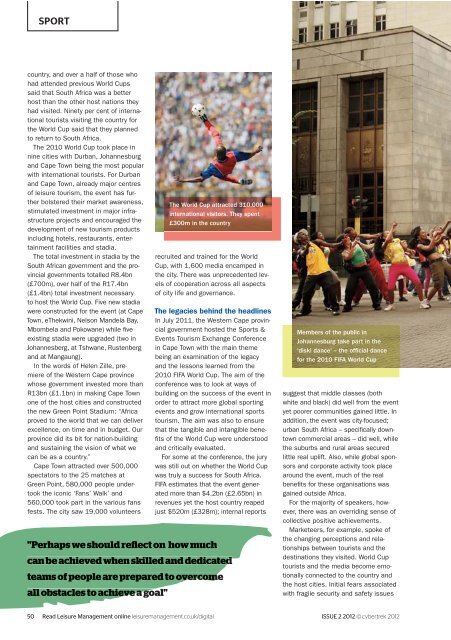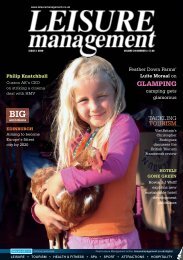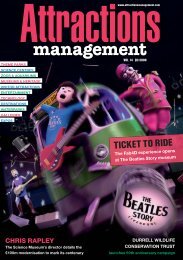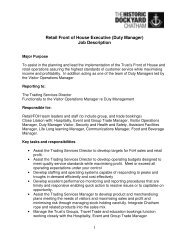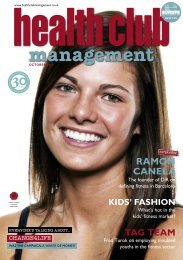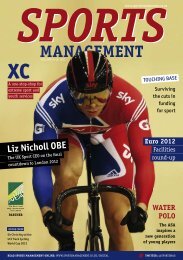sporting - Leisure Opportunities
sporting - Leisure Opportunities
sporting - Leisure Opportunities
Create successful ePaper yourself
Turn your PDF publications into a flip-book with our unique Google optimized e-Paper software.
SPORT<br />
country, and over a half of those who<br />
had attended previous World Cups<br />
said that South Africa was a better<br />
host than the other host nations they<br />
had visited. Ninety per cent of international<br />
tourists visiting the country for<br />
the World Cup said that they planned<br />
to return to South Africa.<br />
The 2010 World Cup took place in<br />
nine cities with Durban, Johannesburg<br />
and Cape Town being the most popular<br />
with international tourists. For Durban<br />
and Cape Town, already major centres<br />
of leisure tourism, the event has further<br />
bolstered their market awareness,<br />
stimulated investment in major infrastructure<br />
projects and encouraged the<br />
development of new tourism products<br />
including hotels, restaurants, entertainment<br />
facilities and stadia.<br />
The total investment in stadia by the<br />
South African government and the provincial<br />
governments totalled R8.4bn<br />
(£700m), over half of the R17.4bn<br />
(£1.4bn) total investment necessary<br />
to host the World Cup. Five new stadia<br />
were constructed for the event (at Cape<br />
Town, eThekwini, Nelson Mandela Bay,<br />
Mbombela and Pokowane) while five<br />
existing stadia were upgraded (two in<br />
Johannesberg, at Tshwane, Rustenberg<br />
and at Mangaung).<br />
In the words of Helen Zille, premiere<br />
of the Western Cape province<br />
whose government invested more than<br />
R13bn (£1.1bn) in making Cape Town<br />
one of the host cities and constructed<br />
the new Green Point Stadium: “Africa<br />
proved to the world that we can deliver<br />
excellence, on time and in budget. Our<br />
province did its bit for nation-building<br />
and sustaining the vision of what we<br />
can be as a country.”<br />
Cape Town attracted over 500,000<br />
spectators to the 25 matches at<br />
Green Point, 580,000 people undertook<br />
the iconic ‘Fans’ Walk’ and<br />
560,000 took part in the various fans<br />
fests. The city saw 19,000 volunteers<br />
The World Cup attracted 310,000<br />
international visitors. They spent<br />
£300m in the country<br />
recruited and trained for the World<br />
Cup, with 1,600 media encamped in<br />
the city. There was unprecedented levels<br />
of cooperation across all aspects<br />
of city life and governance.<br />
The legacies behind the headlines<br />
In July 2011, the Western Cape provincial<br />
government hosted the Sports &<br />
Events Tourism Exchange Conference<br />
in Cape Town with the main theme<br />
being an examination of the legacy<br />
and the lessons learned from the<br />
2010 FIFA World Cup. The aim of the<br />
conference was to look at ways of<br />
building on the success of the event in<br />
order to attract more global <strong>sporting</strong><br />
events and grow international sports<br />
tourism. The aim was also to ensure<br />
that the tangible and intangible benefi<br />
ts of the World Cup were understood<br />
and critically evaluated.<br />
For some at the conference, the jury<br />
was still out on whether the World Cup<br />
was truly a success for South Africa.<br />
FIFA estimates that the event generated<br />
more than $4.2bn (£2.65bn) in<br />
revenues yet the host country reaped<br />
just $520m (£328m); internal reports<br />
"Perhaps we should reflect on how much<br />
can be achieved when skilled and dedicated<br />
teams of people are prepared to overcome<br />
all obstacles to achieve a goal"<br />
Members of the public in<br />
Johannesburg take part in the<br />
'diski dance' – the official dance<br />
for the 2010 FIFA World Cup<br />
suggest that middle classes (both<br />
white and black) did well from the event<br />
yet poorer communities gained little. In<br />
addition, the event was city-focused;<br />
urban South Africa – specifically downtown<br />
commercial areas – did well, while<br />
the suburbs and rural areas secured<br />
little real uplift. Also, while global sponsors<br />
and corporate activity took place<br />
around the event, much of the real<br />
benefits for these organisations was<br />
gained outside Africa.<br />
For the majority of speakers, however,<br />
there was an overriding sense of<br />
collective positive achievements.<br />
Marketeers, for example, spoke of<br />
the changing perceptions and relationships<br />
between tourists and the<br />
destinations they visited. World Cup<br />
tourists and the media become emotionally<br />
connected to the country and<br />
the host cities. Initial fears associated<br />
with fragile security and safety issues<br />
50 Read <strong>Leisure</strong> Management online leisuremanagement.co.uk/digital ISSUE 2 2012 © cybertrek 2012


